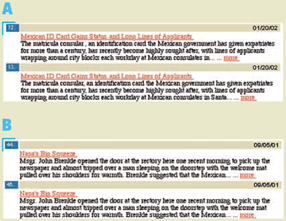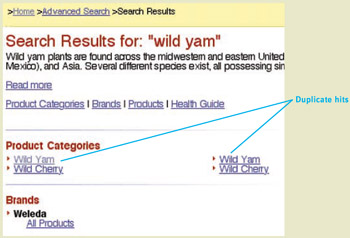Blooper 34: Duplicate Hits
| < Day Day Up > |
Blooper 34: Duplicate Hits
If it's bad for a search facility to return several items that look alike, it must be worse for a search facility to return multiple listings for the same item, right? Yes and no.
Recall our discussion of true versus false versus stealth duplicates (see Chapter 3, Blooper 17: Deceptive Duplicate Links). The basic principle is not to mislead. If two links look the same, they should go to the same place. If they look different, they should go to different places. If they look the same but go to different places (false duplicates), or if they look different but go to the same place (stealth duplicates), they are misleading.
In one sense, a search facility that returns several copies of the same item isn't as bad as one that returns deceptively similar-looking items. It at least doesn't mislead people: Items that look the same are the same.
However, in another sense, returning multiple copies of the same item is a worse blooper. Spool et al. (1999) tested several website search functions on Web users and found that "users didn't like it when the search engine returned multiple instances of the same link." The presence of duplicates in the results greatly lowers people's confidence in a search function. They consider it to be buggy , which in a way it is. If people have low confidence in a search function, they won't use it.
Both false and true duplicate hits can be seen at LATimes.com (Figure 5.24). A search for "ID cards" yielded a long list of articles. Items 12 and 13 look almost exactly alike but aren't: Item 12 links to an article, and item 13 is an invalid link. Since the headline and lead sentence are the same for the two items, one wonders what item 13 used to point to, if not the same article as item 12. Items 44 and 45 point to the same article and so are true duplicates. Though not as confusing as false duplicates, their presence in the results doesn't inspire confidence in the site's search facility.

Figure 5.24: www.LATimes.com (Feb. 2002) ” A ” Two items look alike, but the first link works and the second link is "broken." B ” Two true duplicates.
LATimes.com, including the search facility, was recently updated, but unfortunately the problem of duplicate hits in search results persists.
At VitaminShoppe.com, one can see a different type of duplicate search hit. This site's search facility returns the usual list of products, below categories in the company's product hierarchy that match the user 's search terms. However, something inside the search facility seems buggy: Under Product Categories, we have "Wild Yam" and "Wild Cherry" each listed twice (Figure 5.25).

Figure 5.25: www.VitaminShoppe.com (Feb. 2002) ”Search for "wild yam" yielded duplications in the Product Categories section of the results.
Avoiding the Blooper
The usual cause of Duplicate Hits is quite different from that of Blooper 33 (Hits Look Alike). Results lists of hard-to-distinguish items are the fault of poor user-interface design. In contrast, duplicate hits are the fault of poor back-end design:
-
Databases that are so poorly organized, they contain duplicates
-
Middleware that doesn't detect duplicates found via different routes
-
Server-side applications that don't attempt to organize what the database and middleware return before presenting it to users
This blooper thus provides a clear example of back-end flaws causing a usability problem. Therefore, the main design guideline for avoiding duplicate search hits is as follows :
Ensure that either the database doesn't contain duplicates or the search facility can filter them out before presenting results to users.
Web-development managers, take note: This means that website usability is the responsibility of back-end developers and Web designers.
| < Day Day Up > |
EAN: 2147483647
Pages: 128